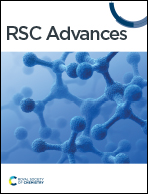A high-performance room-temperature NH3 gas sensor based on WO3/TiO2 nanocrystals decorated with Pt NPs†
Abstract
In this work, a high-performance room-temperature ammonia (NH3) gas sensor based on Pt-modified WO3–TiO2 nanocrystals was synthesized via a two-step hydrothermal method. The structural properties were characterized by scanning electron microscopy, transmission electron microscopy, X-ray diffraction, and X-ray photoelectron spectroscopy. The 10 at% Pt@WO3–TiO2 nanocrystals present the highest NH3 sensing performance at room temperature. Compared with the nanocrystals without Pt modification, the sensitivity of the Pt@WO3–TiO2 sensor is tenfold higher, with the lowest concentration threshold reaching the 75 ppb level. The response is approximately 92.28 to 50 ppm, and response and recovery times are 23 s and 8 s, respectively. The improved sensing was attributed to a synergetic mechanism involving the space charge layer effect and Pt metal sensitization, enhancing the electron transfer efficiency, oxygen vacancy and specific surface area. This study is expected to guide the development of high-performance room-temperature ammonia sensors for clinical breath testing.



 Please wait while we load your content...
Please wait while we load your content...